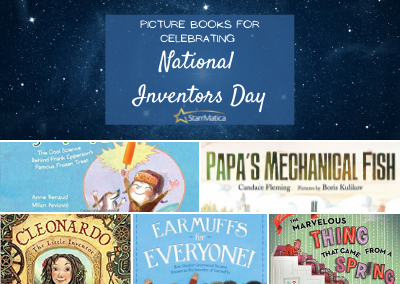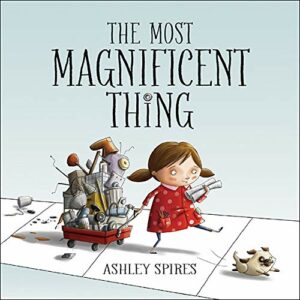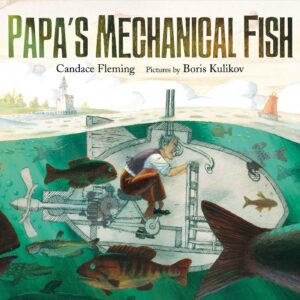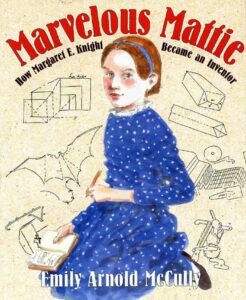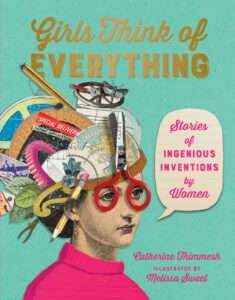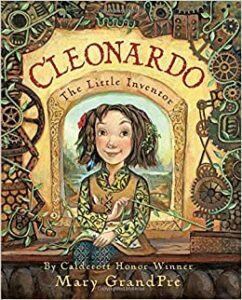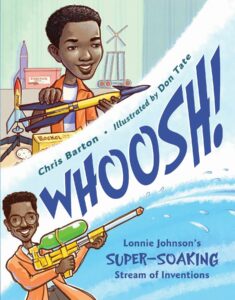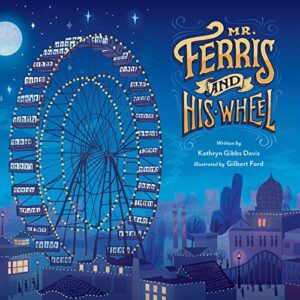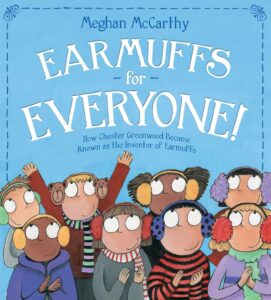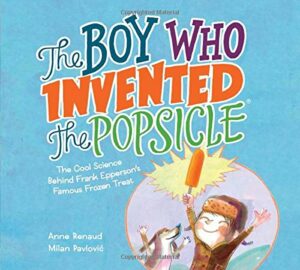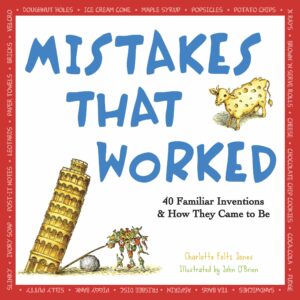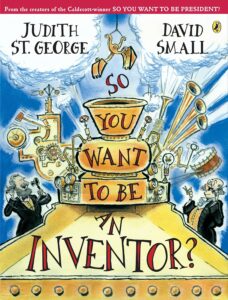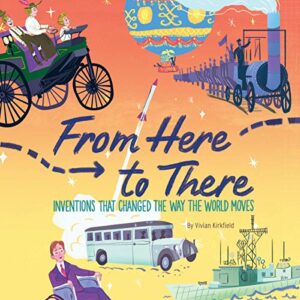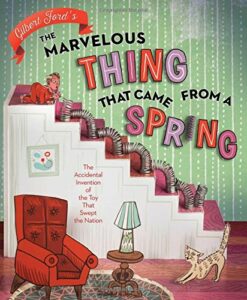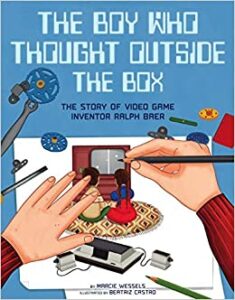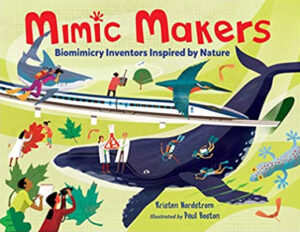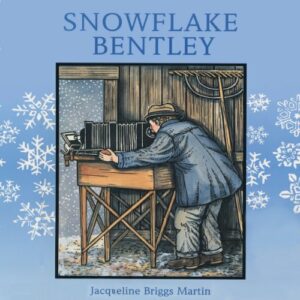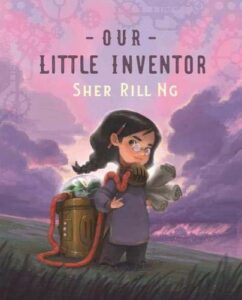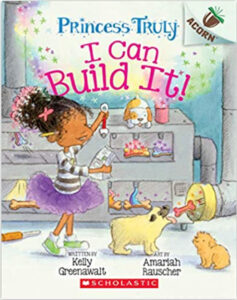Imagine what your life would be like without a TV. What about a vacuum cleaner? Your refrigerator? Toilet paper? Soap? Most of these common household items would be hard to live without, and we have inventors to thank for them!
Every year on February 11th, National Inventors’ Day honors the inventors of the past, the creators of the present, and encourages the thinkers of the future. In 1983, President Ronald Reagan proclaimed the first National Inventors’ Day and it takes place every year on Thomas Edison’s birthday.
Help your class celebrate inventors far and wide by reading some of these books together. Here are just a few of our favorite picture books for celebrating National Inventors’ Day:
The Most Magnificent Thing by Ashley Spires
Description: The engaging text and interesting illustrations will draw your students into this story of perseverance and creativity. A girl sets out to invent the most magnificent thing, thinking it will be easy. She finds that creating the perfect invention isn’t quite as straightforward as she thought and failures may not be quite what they seem.
Questions to explore: What character traits does the girl display that you think will help you when you try to make a magnificent thing? What would your magnificent thing look like? What would it do?
Papa’s Mechanical Fish by Candace Fleming
Description: Loosely based on the life of Lodner Phillips, creator of one of the first modern submarines, this is a story about “Papa” who tinkers all day long and is inspired by what it might be like to be a fish. He builds a design, it fails, he redesigns it, it fails again, then back to the drawing board he goes again! “Papa” is determined, resilient, and creative. Learning from your mistakes is a common theme among many of our books on this list, and “Papa” fully embraces that philosophy!
Questions to explore: How did Papa use his background knowledge on fish to help him with his design? Did his first design work? Why or why not? Do you think Papa is a successful inventor? What evidence from the text supports your answer? Compare the story with the author’s note in the back of the book. What parts of the story are true?
Marvelous Mattie: How Margaret E. Knight Became An Inventor by Emily Arnold McCully
Description: As a kid, Margaret “Mattie” Knight was always brainstorming, sketching ideas, and building things. She saw problems as opportunities to make improvements to the things that already existed, like how to make machines safer or more efficient. She is known for inventing the design and the machine to build the square-bottom paper bag, which we still use to this day! A true pioneer of her time, this book will leave you feeling inspired by Mattie’s determination and perseverance!
Questions to explore: Why do you think the man tried to steal Mattie’s patent, and how did she prove that the invention belonged to her? Today, Mattie is known as “the Lady Edison.” What do you think this means?
Girls Think Of Everything: Stories Of Ingenious Inventions By Women by Catherine Thimmesh
Description: Throughout history, women have always been innovators. But their accomplishments have often been downplayed, skimmed over, or ignored all together. Against the odds, women have invented. This book is a celebration of those women. Each chapter is about a different woman and the invention she is known for. Some are common inventions we all know like windshield wipers and chocolate chip cookies, and some are less known but still just as important. While technically not a picture book, this is a great book for older students to explore independently, as a research project, or as a class read-aloud focusing on one or two stories each day.
Questions to explore: Why do you think womens’ inventions have historically been downplayed or ignored? What great ideas do you have to solve a problem or improve on an existing invention?
Cleonardo, The Little Inventor written and illustrated by Mary GrandPré
Description: With a nod to Leonardo DaVinci, this book tells the tale of Cleonardo, who like her father Gleonardo, loved to tinker, create, and invent. But Cleo’s dad never seems to want her help, so she decides to get his attention by entering the annual invention contest. Through a series of tumultuous events, the two discover that they love it best when they can work together side by side as inventors.
Questions to explore: What do you think is the purpose of Cleo’s invention? What would you invent for an annual invention contest?
Whoosh! Lonnie Johnson’s Super-soaking Stream Of Inventions by Chris Barton
Description: Lonnie Johnson was always building things as a child – rockets, robots, and more. He later worked for NASA and helped with the orbiter that studied Jupiter. But, he is best known as the inventor of the Super Soaker! This is the story of how he unexpectedly invented this popular toy and how he persevered through many challenges in order to finally succeed.
Questions to explore: What advice would you give to someone who was looking to create and sell their new invention? Use evidence from the book to support your advice?
Mr. Ferris and His Wheel by Kathryn Gibbs Davis
Description: Learn all about George Ferris Jr. who designed and built the first Ferris Wheel for the 1893 World’s Fair in Chicago. Built as a rival to the Eiffel Tower, Ferris defied odds, criticism, natural elements, and time to successfully build his wheel that is now an iconic feature of most amusement parks and fairs today.
Questions to explore: What were some of the things that inspired George’s Ferris Wheel design? What other inventions do you think those things could inspire? Choose another invention. What things do you think might have inspired its design? Why?
Earmuffs For Everyone! How Chester Greenwood Became Known As The Inventor Of Earmuffs by Meghan McCarthy
Description: This fun and quirky story is about Chester Greenwood, who is known for inventing the earmuffs even though earmuffs had been around since before Chester Greenwood was born. The story goes that Chester had big ears and they were always cold so he took the earmuffs that existed and improved upon the design by making the hard steel band that held the earmuffs in place, then he patented it. This tale brings to light the fact that inventors don’t always have to come up with something original in order to be considered an inventor – improving upon something that already exists is still an invention!
Questions to explore: The earmuffs that Chester Greenwood patented in 1877 are still very similar to the earmuffs you can buy today. Why do you think this is? Why do you think Chester became known as the inventor of earmuffs even though he wasn’t? What invention would you like to improve upon? How would you improve it?
The Boy Who Invented the Popsicle by Anne Renaud and Milan Pavlovic
Description: Interspersed with amazing hands-on experiments to investigate, this is the story of Frank Epperson who was always thinking and asking questions… one of which led him to inventing the popsicle!
Questions to explore: How does this book celebrate the connection between science and fun, as well as the importance of using evidence to support a claim?
Mistakes That Worked: The World’s Familiar Inventions And How They Came To Be by Charlotte Foltz Jones
Description: This is a fun book with short stories dedicated to the ‘mistakes’ that turned into inventions that we use on a daily basis: potato chips, maple syrup, Velcro, paper towels, and more! While technically not a picture book this is a fun book for older students to explore independently, or to use as a class read-aloud focusing on a few stories each day. Filled with fun facts and comical illustrations, this book is a celebration of all the inventors who were not afraid of making mistakes: “It is easy to fail and then abandon the whole idea. It’s more difficult to fail but then recognize another use for the failure.”
Questions to explore: What accidental invention are you most surprised by? Which ‘mistake’ would you miss the most if it had not been accidentally discovered?
So You Want To Be An Inventor? by Judith St. George
Description: A perfect introduction to the wacky and interesting world of inventors and inventing, this book lists character traits about inventors and then gives facts about different inventors that fit those traits. Whether you’re a dreamer, work all night, are laughed at, prefer to work alone, or put yourself in danger, the bottom line is YOU can be an inventor and your invention could change the world. It has happened!
Questions to explore: After reading this book, do you want to be an inventor? Why or why not? Use evidence from the text to support a claim about whether or not you have what it takes to be an inventor.
From Here To There: Inventions That Changed The Way The World Moves by Vivian Kirkfield
Description: This book that focuses on the inventions that help us get from here to there: a bicycle, a car, a wheelchair, and a steam locomotive to name a few. While technically not a picture book this is a fun book for older students to explore independently, or use as a class read-aloud focusing on one chapter each day. This book celebrates both the inventors of the past and the inventors who wanted to improve upon those designs to make them faster and more efficient.
Questions to explore: What do many of the inventors in the book have in common? Why do you think that is? Choose a transportation device that exists today that you would like to improve. What would those improvements look like, and how would you make them happen?
The Mar樂威壯
velous Thing That Came From A Spring: The Accidental Invention Of The Toy That Swept The Nation by Gilbert Ford
Description: With quirky illustrations that feel like a mix between a magazine collage and I Spy photographs, this book tells the tale of the Slinky – an accidental toy that swept the nation with its popularity. Richard James was an engineer tasked with a job to prevent equipment on US Navy ships from vibrating during rough seas. One night a spring accidentally fell from a shelf and he watched in amazement as the coils “took a walk” across his desk, and an idea was born! In 1945, Richard and his wife Betty started their Slinky business. Thanks in large part to his wife’s efforts, they would eventually sell more than 250 million of the toys and are still making new toys to this day.
Questions to explore: Have you ever played with a Slinky? What makes them fun? Have you ever played with something that wasn’t meant as a toy? What made it fun to play with?
The Boy Who Thought Outside The Box: The Story Of Video Game Inventor Ralph Baer by Marcie Wessels
Description: A sure-fire winner of a topic in most classrooms these days is video games! But, have you ever wondered where they came from? This book tells the story of Ralph Baer, who invented the first video game system – the Magnavox Odyssey. Ralph’s life was not easy growing up. He fled Nazi Germany with his family, and made a new life for himself in the United States. Then faced with rejection after rejection of his video game system, Ralph did not give up. Like a true inventor, his perseverance in the face of adversity is an inspiration to us all!
Questions to explore: Where did Ralph’s idea for a video game come from? Why do you think so many companies rejected the idea?
Mimic Makers: Biomimicry Inventors Inspired by Nature by Kristen Nordstrom
Description: Learn more about ten different inventors who looked to the natural world for inspiration to solve a problem. From trains designed after a bird’s beak to wind turbines designed after a whale’s flippers, this book explores the fascinating world of biomimicry inventions. We think this is a perfect fit for our National Inventors Day book list!
Questions to explore: What invention would you create that is inspired by nature?
Snowflake Bentley by Jacqueline Briggs Martin
Description: This is the story of Wilson Bentley, who loved snow and ice crystals more than anything else in the world and was determined to share their beauty with the rest of the world. While not an inventor in the traditional sense of the word, W.A. Bentley worked for 50 years to perfect the technique of microphotography to reveal the mystery of the snowflake. Even today, those wanting to learn more about snowflakes begin with Bentley’s book, Snow Crystals.
Questions to explore: Why is it so tricky to photograph snowflakes? What variables affect the way a snowflake is formed?
Our Little Inventor by Sher Rill Ng
Description: A beautifully illustrated book about a little girl named Nell with a big dream to make the world a better place, starting with her town. Nell lives in the countryside, but the Big City not far away is growing polluted more and more every day, and it’s not safe for people to live in. She invents a machine that will help clean the air and make the city safe again. Her only obstacle is getting the people in charge to listen to her! With grit and determination, Nell is determined to succeed. Though fictional, this story is a perfect example of how an inventor tries to solve a problem in order to help others and doesn’t give up until she’s successful!
Questions to explore: What do you think happened to the Big City to make it so polluted? Do you think Nell’s invention will solve the problem? What other solutions can you think of to help with the problem of polluted air in the Big City?
I Can Build It! by Kelly Greenawalt
Description: A fictional picture book about a girl named Princess Truly who loves to build, tinker, invent, and help others. With her “rainbow power” she can make interesting things happen that would otherwise not be possible – bikes that fly and machines that make dog snacks out of nothing. Even though fictional, this fun rhyming book helps remind us that inventors come in all shapes, sizes, colors, gender, and ages!
Questions to explore: Princess Truly builds a snack machine for the dogs. What would you build? How would your machine help? How would your machine work?
Looking for more texts for your science classroom, check out StarrMatica Texts: Science Your Way Each K-5 NGSS-aligned text has has multiple reading levels so all of your students can read the same content independently.
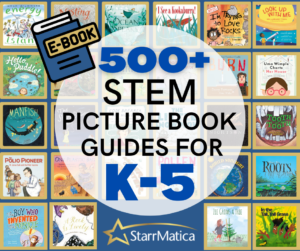 And if you are looking for additional picture books for your science classroom, check out the Perfect Picture Book Pairing Series that includes one-page guides with activities and discussion questions for hundreds of STEM-themed picture books aligned to every NGSS performance expectation!
And if you are looking for additional picture books for your science classroom, check out the Perfect Picture Book Pairing Series that includes one-page guides with activities and discussion questions for hundreds of STEM-themed picture books aligned to every NGSS performance expectation!
CLICK HERE TO PREVIEW THE PERFECT PICTURE BOOK PAIRING EBOOKS
Are you on Social Media? Use the hashtag #NationalInventorsDay to share how you celebrated the day. We would love to be tagged in your posts, too!

